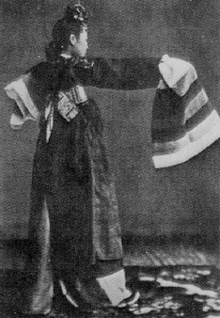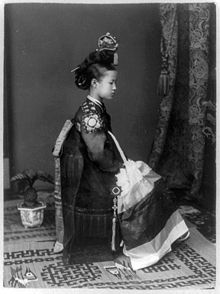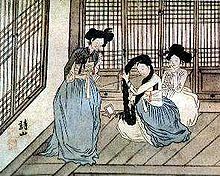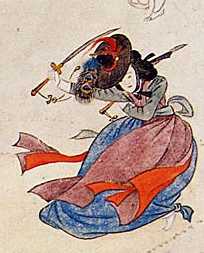Kisaeng: They’re Not What You Expected, Right? (Week 3)
Nadia w -
It’s spring break! How about we follow what the others are doing and do an info-dump? This week, I’ll dive into the history of the Kisaeng in the Joseon Period. Hwang Jini, the author from this time that I chose, is one of the most renowned Kisaeng in the world!

General
Kisaeng, as I’ve mentioned before, were not prostitutes; rather, they were the entertainers of the era, playing music, dancing, and creating art for their rulers and higher-ups. They were revered for their talent and, especially, their loyalty – enough so that Kisaeng were often used as heroines in stories of the time. Despite this, though, they were still considered 천민 (Cheonmin), which was the same class as the slaves and the butchers, the lowest of the low.
Kisaeng were essentially slaves of the government. There were records of each and every Kisaeng, purely so that they could keep track of their progress in their training. Wealthy patrons would sometimes buy a Kisaeng, but the price was large enough that one can tell that the government didn’t want to give up their girls. The Kisaeng got in-depth education, mostly about music and dance (but still, women were generally not allowed to be educated in this period, so the fact that they were getting any sort of education was all but groundbreaking.)

Hierarchy Within
In the Late Joseon Dynasty (the second half), a 3-tiered system emerged. First (일베), Second (이패), and Third (삼패). The Kisaeng in the first tier were called Haengsu, the second Seongsang, and the third Samsu. All of these titles came with their own connotations and their own ‘rights’. Haengsu were considered the leaders; they would help train up the younger Kisaeng that were in school and they solved disputes between the girls as well as between patrons and kisaeng. These girls were also able to choose whether or not to entertain patrons, which was a huge privilege. Seongsangs were a step below the Haengsu; they wouldn’t step in where arguments broke out, but they would sometimes help with training the younger girls. Those with these two titles got to learn not only dance and music, but also poetry and art. Samsu were considered little more than slaves; they learned dance and music, but were forbidden from performing anything that the girls in higher tiers got to, including the dances.

Becoming Kisaeng
These girls became Kisaeng in one of three ways: they were born into it, they were sold into it, or they were punished with it. The Kisaeng title was an inherited one, so any children that a woman with that status had would pretty much get the same title on site. Many Cheonmin were poor (hence the low class-ranking) and would be paid for their daughters if they sold them to the government. It was a way to simultaneously make sure their daughters were taken care of and get a bit of money to tide them over. (I couldn’t find how much the girls would be sold for, unfortunately.)
Lastly, if a girl in an aristocratic family violated the Joseon’s strict sexual mores, they would essentially be ‘demoted’ to Kisaeng status. Really, they would be punished with it. Their families would not only lose their daughter, but they wouldn’t profit in the least from the switch, which was incentive enough for the leaders of the family (the husbands) to keep their daughters in line.

Career
A Kisaeng’s career was surprisingly short. The girls would start training at as early as 8 years old, would hit their peak at 16 or 17, and then most would retire from entertaining around the age of 22. If they were still entertaining later, though, then they would be forced to retire at 30 years old. Keep in mind, the life expectancy in the early Joseon Dynasty was about 35, with most males living to 24 and most females living to 26. Later on, with medicinal updates and breakthroughs, the life expectancy shot up to 69.
Although their careers as Kisaeng were shorter, they were still able to work afterwards. They would buy or work for taverns to make some money, but only if they didn’t become concubines (a woman who lives with a man without being married to him, a secondary wife with less rights) or weren’t bought by wealthy aristocrats. They were all forced to retire from working in general by 50.

Kisaeng were required to pay for and provide necessities for themselves. They got paid for their performances (something that put them apart from general slaves), and so were fairly wealthy, but any and all money they made tended to go towards their personal funds which were used to pay for things like makeup and food.
Thanks for reading! This is barely scratching the surface of what I know about Kisaeng, so if you have any questions about something specific, let me know!

Comments:
All viewpoints are welcome but profane, threatening, disrespectful, or harassing comments will not be tolerated and are subject to moderation up to, and including, full deletion.